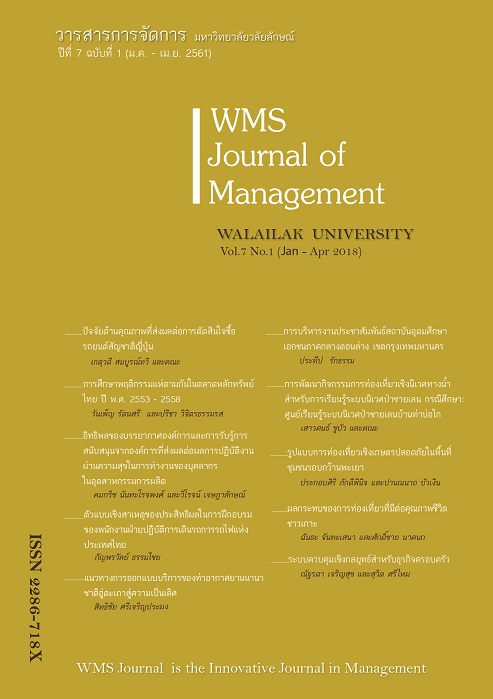Ecotourism Water Activity Development for Mangroves Ecosystem Learning A Case Study of the Mangrove Ecosystem Learning Center at Barn Tha Bor Koh
Main Article Content
Abstract
The purposes of this research were to 1) study the mangrove ecosystem potentiality at Barn Tha Bor Koh 2) develop the Ecotourism water activity for learning mangrove ecosystem and 3) determine the participates’ opinions after participate with the Ecotourism water activities. The sample group was consisted of 25 volunteers with the voluntary participation of the water activities for learning mangrove ecosystem. The study tools using percent, mean, standard deviation, and content analysis.
Results of the study showed that 1) the mangrove ecosystem potentiality has a high biodiversity because of the nature of terrain is different consisting of mountains, plains and wetlands. It found the residents of plants and animal species. A mixed of swamp and mangrove forest 2) the developed Ecotourism water activity was kayaking for learning mangrove ecosystem composed of 3 waterways that comprised Route 1st : departure at the starting point direct to Klong Bang Kha Narn, Klong Khanom and turn back the same way, distance about 2.8 kilometers took around 1.30 hours. Route 2nd : departure at the starting point direct to Klong Neaw Keat, Klong Khanom and turn back the same way, distance about 4 kilometers took around 2 hours. Route 3rd : departure at the starting point direct to Klong Neaw Keat, Klong Khanom and turn back passed Klong Bang Kha Narn, distance about 3.8 kilometers took around 2 hours. 3) the participants’ opinions showed that a 2-seats kayak was suitable for water activity at the highest level. The number of procession should have 4-6 boats per time or group. The Mangrove Ecosystem Learning Center at Barn Tha Bor Koh was important for develop a water activity at a high level and should enhance its activities such as bird conservation, garbage collection and listen to the local guides’ storytelling. Moreover the participants were impressed Route 1st at the most because the distance is not very far also impressed all three routes because all routes are beautiful and fit to learn. For facilities along the route should provide signposts, plants’ label, map of the routes and stopover points, respectively.
Article Details
References
นงลักษณ์ วิรัชชัย. (2543). การวิจัยเพื่อพัฒนาการเรียนการสอน : การวิจัยปฏิบัติการของครู.เอกสารจัดพิมพ์เนื่องในโอกาสเกษียณอายุราชการ.
บุญชม ศรีสะอาด(2559). การแปรผลเมื่อใช้เครื่องมือรวบรวมข้อมูลแบบมาตราส่วนประมาณค่า. สืบค้นเมื่อ 20 สิ่งหาคม 2559. สืบค้นจาก http:// www.watpon.com/ boonchom/05.doc.
พิมพ์ลภัส พงศกรรังศิลป์ (2557) การจัดการการท่องเที่ยวชุมชนอย่างยั่งยืน: กรณีศึกษา บ้านโคกไคร จังหวัดพังงา. วารสารวิชาการ Veridian E-Journal ปีที่ 7 ฉบับที่ 3 เดือนกันยายน- ธันวาคม.
วิภาวี พลรัตน์ (2551) พัฒนารูปแบบการท่องเที่ยวเชิงนิเวศทางน้ำ กรณีศึกษา ย้อนร้อยเส้นทางประวัติศาสตร์อดีตราชธานีกรุงธนบุรี. ปริญญานิพนธ์วิทยาศาสตร์มหาบัณฑิต สาขาวิชาการวางแผนและการจัดการเพื่ออนุรักษ์สิ่งแวดล้อม บัณฑิตวิทยาลัย มหาวิทยาลัยศรีนครินทรวิโรฒ.
ล้วน สายยศ และ อังคณา สายยศ. (2538). เทคนิคการวิจัยทางการศึกษา. กรุงเทพมหานคร: สุวีริยาสาส์น.
สุภาพร สุกสีเหลือง และคณะ. (2553). การท่องเที่ยวเชิงนิเวศและความหลากหลายทางชีวภาพ คู่มือศึกษาสิ่งมีชีวิตบริเวณชายฝั่งทะเล. กรุงเทพมหานคร: สถาบันพัฒนาการท่องเที่ยวเพื่ออนุรักษ์สิ่งแวดล้อม มหาวิทยาลัยศรีนครินทรวิโรฒ.
สำนักอุทยานแห่งชาติ กรมอุทยานแห่งชาติสัตว์ป่าและพันธุ์พืช. (2559). หาดขนอม-หมู่เกาะทะเลใต้. สืบค้นเมื่อ 20 สิงหาคม 2559. สืบค้นจาก http://park.dnp.go.th/visitor/ nationparkshow.php?PTA_CODE=9145


